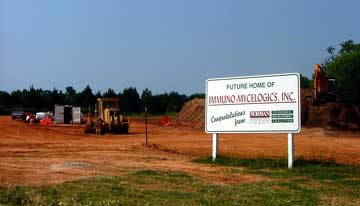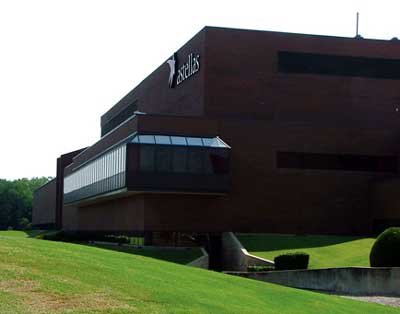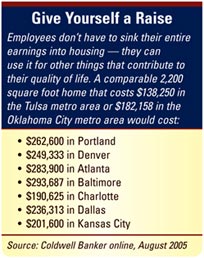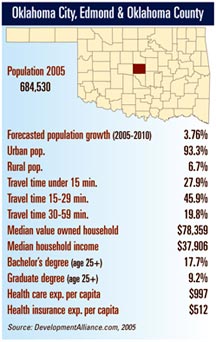
SEPTEMBER 2005
Oklahoma: An Editorial Survey (cover)
Once They Get Here
Textbook Case: Universities and the Telecom Cluster Are on the Same Page (sidebar)
Perception Is Not Reality
How Innovation Becomes Commercialization (sidebar)
Business Climate Brightens
Research Campus Key to City's Health Science Hub (sidebar)
Reporting for Duty; 'Coopetition' Is Key to Aviation Cluster Success (sidebar)
Oklahoma City Re-"MAPS" Its Future (sidebar)
Today's Forecast Calls for a New Industry Cluster (sidebar)
How Tulsa Is Funding a Metropolitan Makeover (sidebar)
Business Cost Advantage
Thank You, Texas
Distribution Center Locations Abound
CSI: Edmond (sidebar)
Making the Workforce Competitive
Wind Joins the
Energy Cluster
A New Day for Oil
and Gas
Pryor Claims Part of the NAFTA Corridor
Request Information


|
|

|
|
Immuno-Mycologics, which manufactures fungal diagnostic products, is building a 14,000-sq.-ft. (1,300-sq.-m.) research and development center in Norman, just south of Oklahoma City. The facility will open in early 2006. On a larger scale, Astellas Pharma moved its R&D center to Norman in 2001 from Palo Alto, Calif. The Oklahoma City area will see more biotech and pharmaceutical industry investment as those sectors discover the cost advantages of the region relative to better-known science centers.
In August, biotech industry operating cost analysis from The Boyd Company, Inc., a site location consultancy, identified Oklahoma City as the lowest-cost of 60 markets examined. Annual operating costs for a construction assumption of a 200,000-sq.-ft. (18,580-sq.-m.) R&D facility employing 200 are $15.3 million. The highest-cost market looked at was San Francisco at $22.4 million. |
| W |
hen the youngster in the Dr. Seuss classic "Green Eggs and Ham" finally gives in and tries the colorful dish, he soon realizes Sam I Am was right. Executive after executive in Oklahoma's key industries are telling the same story to job candidates they are recruiting from elsewhere, industry peers mulling an Oklahoma location and the merely curious where the nation's 46th state is concerned. Having made the transition themselves in many cases, senior executives in the aerospace, logistics, energy, life sciences and other industries are eager to set the record straight.
In Oklahoma City, for instance, Boeing employs doctorate-level engineers who design software and hardware for weapons systems. "They are the most elite of the elite among engineers, and they are very hard to move — once you hire them, they generally stay where they are," says Steven Hendrickson, director of Boeing's
 Strategic Planning & Communications
unit in Tulsa. "They are typically located in Seattle, southern California, Philadelphia and St. Louis on rare occasions.
We find ourselves convincing them to come to Oklahoma, because their perception of the state is usually bad. But as soon as we get them here, we can't get them to leave."
Strategic Planning & Communications
unit in Tulsa. "They are typically located in Seattle, southern California, Philadelphia and St. Louis on rare occasions.
We find ourselves convincing them to come to Oklahoma, because their perception of the state is usually bad. But as soon as we get them here, we can't get them to leave."
Boeing came close to having plenty of other workers on its Oklahoma payroll, adds Hendrickson. "The site-selection consultants working on the Boeing 787 location decision can't tell you this, but I will: Oklahoma came in second," he says. "The only reason we came in second was that the state was not able to come up with an entire annual budget worth of incentives."

Hendrickson, who also is chairman of the Governor's Council for Workforce and Economic Development, was present at nine of the 27 state presentations making their case for the 1,200-job production facility. "What distinguished Oklahoma from the others was the seamless nature of the levels of government as they were presented. You could not tell, unless you specifically asked the question, at which level of government a presenter was representing. It was seamless." Other states took more of a "silo approach" to luring the facility, says Hendrickson, where representatives of state government, local
 government, higher education, economic development and other entities spoke of their own contribution to the proposal with little awareness of the competing state's broader value proposition.
government, higher education, economic development and other entities spoke of their own contribution to the proposal with little awareness of the competing state's broader value proposition.
In 2001, Yamanouchi Pharmaceutical moved its research and development operations from Palo Alto, Calif., to Norman, Okla., where a subsidiary owned a manufacturing facility. (Following Yamanouchi's merger with Fujisawa Pharmaceutical, the organization was renamed Astellas Pharma.)
"One of the concerns at the time was whether we could get scientists to move from sunny California to Norman, Oklahoma," says Suzy Hurt, Astellas' vice president of business operations. "In fact, very few people transferred, and the concern then became, would we be able to attract people to Norman? And, in fact, we were able to attract everybody we needed to come here. Some are concerned about getting employees to come to this part of the country," she adds. "The ability to attract people is always a concern, but we have found no issue with that. We've found plenty of people who want to get out of the grind of the lifestyle and commutes of the east and west coasts."
The 2005 Oklahoma Legislative Session |
 Key legislation passed in the most recent legislative session includes the following measures of interest to business and industry: Key legislation passed in the most recent legislative session includes the following measures of interest to business and industry:
|